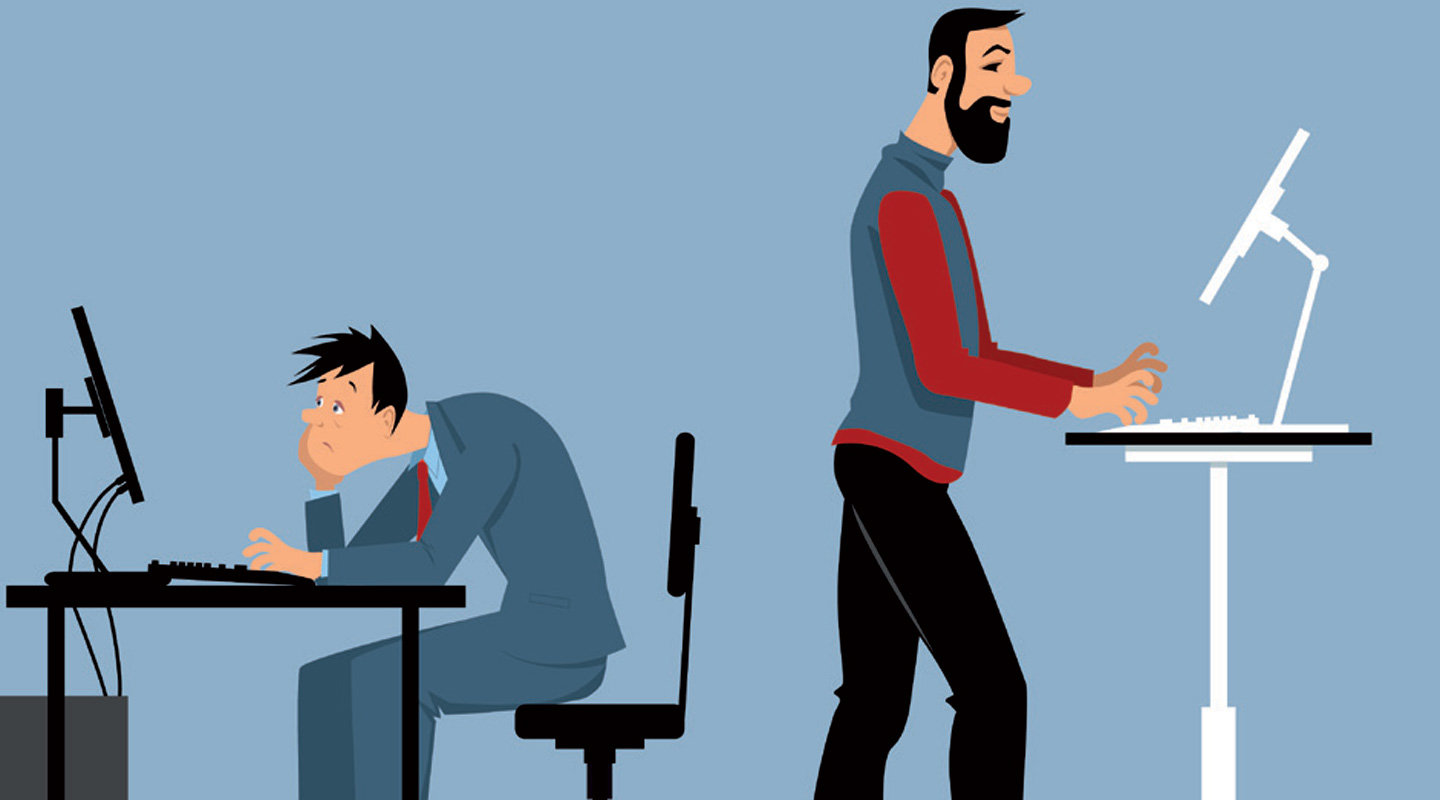敬告讀者: 《中大通訊》已停刊,本網暫停更新。請移玉步造訪本校最新通訊《走進中大》網頁:https://focus.cuhk.edu.hk,閱讀大學報道和消息。
棟篤幹

If this marks the first time you’ve heard this, consider it your initiation into the ever-expanding community of people who have grown weary of taking a seat. While the title quip may be an exaggerated appraisal, more and more cubicle-bound personnel are taking a stand—literally—towards a more health-conscious lifestyle.
Odds are you’ve taken notice. Have you ever seen that one person who insists on standing up to work, as if to grandstand their health-conscious lifestyle? Maybe that health nut is onto something; there are no shortage of studies documenting the correlation between sitting and negative health consequences. With the advent of technology and everyday conveniences, ‘sedentary’ has never been a more fitting lifestyle description. Silly as it may seem to work upright, a standing desk may be just what the doctor ordered.
Often we dissociate lifestyle from work, viewing the two as disparate realms. The division has its merits: it helps us leave work at work, leave home at home, and avoid the mixture of business and pleasure. Yet, our own well-being blurs the work-lifestyle demarcation that many of us so vehemently adhere to. Each of us carries our health back and forth between the office and the dinner table, between research meetings and family barbecues. Each day, how we feel dictates the fullness with which we can live our lives and the productivity of our workday. Sitting down interminably erodes our health and dampens productivity, whether we know it or not.
A slew of ailments can be sourced to overextended hours (or years) of sitting down. Each time we sit, our hip flexors shorten and can lose flexibility over time. Remaining seated for long hours, day in day out, places our hip in constant flexion. Very little hip extension occurs during a seated workday, ultimately shortening the involved tendons and impinging upon mobility. If neglected, posture may suffer—not to mention an increased risk of obesity, back pain, inflammation, lack of mobility, and joint issues.
I started using a standing desk a few months ago here at CUHK. I do the majority of my writing and editorial work standing up. While there are other factors involved, I believe my productivity is higher when I’m standing as opposed to sitting. My energy levels remain high and it’s easier for me to stave off creeping drowsiness while I’m on my feet. In my chair, I often find myself in that lethargic position of resting my head in my hands—this position is wholly impossible while standing upright.
Sitting down incites slouching and can damage our posture, especially in the late afternoons as our energy wanes. With spending a full day in a chair, sometimes I unknowingly found myself slinking deeper and deeper with each passing hour. My shoulders raised well above my ears and my spine resembled a strand of loose spaghetti amid my slouch.
My standing desk has resulted in less time sitting down, thus less time spent slouching in a chair. My back, shoulders, and neck especially have benefitted. The standing desk helps me remain mindful about my posture, allowing me to put in more regular, conscious effort to keep my spine and back straight.
Of course, there are detractors of the standing desk phenomenon (beyond individuals who feel self-conscious when they see people being proactive about their health). While the benefits of sitting for fewer hours remain, studies have also surfaced about the detriments of standing for extended periods of time, with reports of lower limb swelling and decreases in alertness.
CUHK’s Director of University Safety, Mr. Ralph Lee, expanded upon this: ‘We cannot be oblivious to potential health problems instigated by prolonged standing. Apart from the likelihood of developing varicose veins, some studies suggest the load on the spine is higher, causing shrinking of the lumbar spine.’
Further, reports of decreased mental acuity could stem from increases in physical fatigue or discomfort from standing up. For these reasons, a study published in Ergonomics, a research journal that focuses on human interaction with products, concluded that a standing desk should be implemented with caution.
Personally, I spend about four hours standing up to work each day and about four hours seated. Some days I’ll stand for the entire morning and sit for the entire afternoon. Other days I’ll rotate an hour of each at a time. The combinations vary and depend on what you’re comfortable with; there isn’t an exact prescription.
‘Alternating between sitting and standing would be desirable and recommended. After all, too much of anything could be a bad thing,’ added Mr. Lee.
A standing desk is one more way to, ultimately, take a stand for a healthier lifestyle.
Phil Rosen
本文出自《中大通訊》第542期(2019年9月)